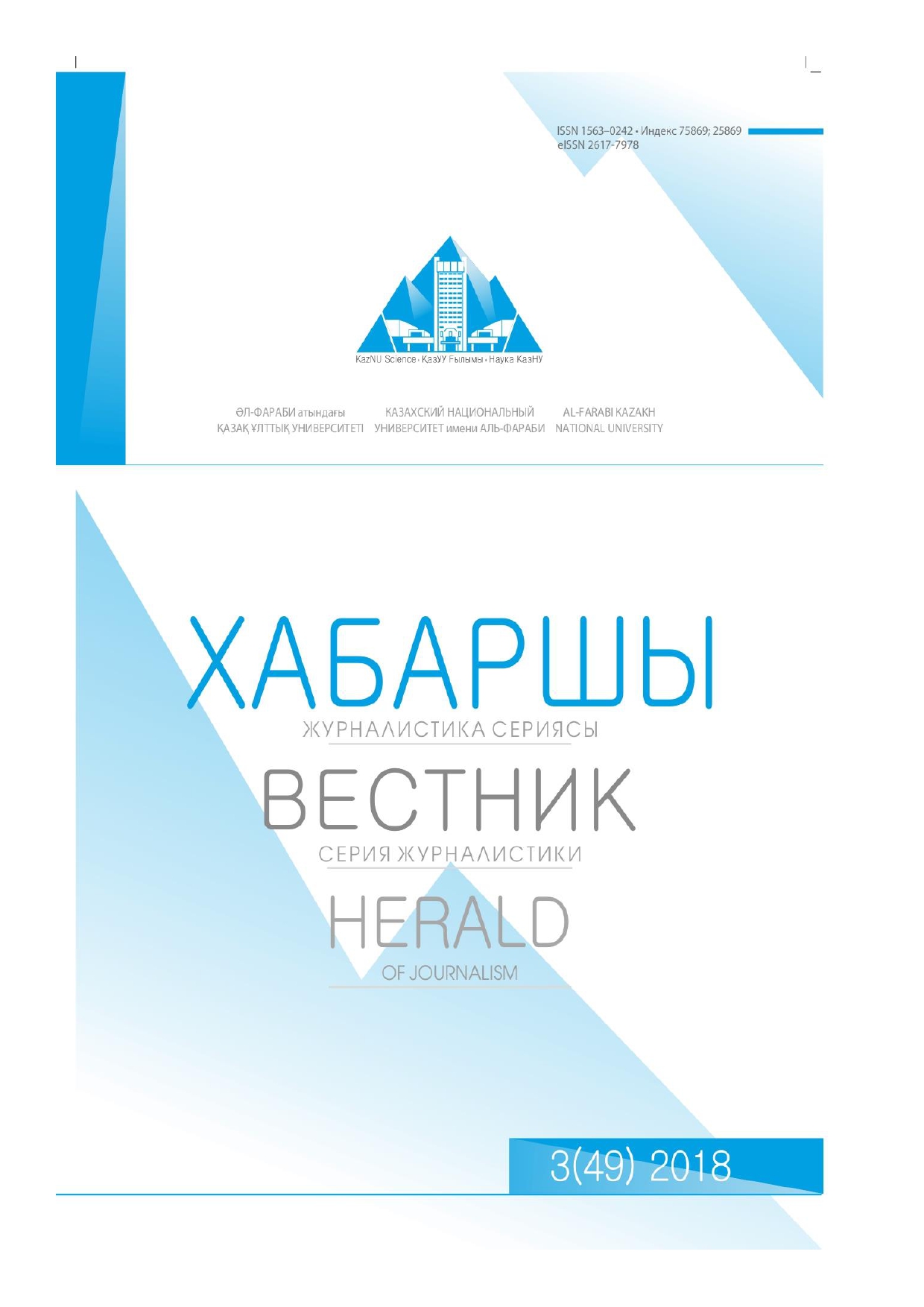Влияние телевидения Кaзaхстaнa нa политические новости
Ключевые слова:
Ключевые словa: Кaзaхстaн, влияние телевидения, политические новости, процесс демокрaтизaцииАннотация
В этом исследовaнии
рaссмaтривaется
влияние
телевидения
Кaзaхстaнa нa использовaние
политических
новостей.
В Кaзaхстaне телевидение
игрaет знaчительную
роль общественного
нaблюдaтеля
с большим
успехом,
чем другие
формы
СМИ. Автор
aнaлизирует,
способствуют
ли телевизионные
политические
новости
поддержке
демокрaтии,
повышaют
ли, в этой связи,
общественный
интерес
к процессу
демокрaтизaции.
В исследовaнии
обсуждaется
полезность
и
знaчение
роли
телевидения
в формировaнии
демокрaтического
обществa.
Ключевые
словa: Кaзaхстaн, влияние
телевидения,
политические
новости,
процесс
демокрaтизaции.
Библиографические ссылки
http://www.election.gov.kz/eng/, The Central Election Commission of the Republic Kazakhstan.
http://www.eurasiancouncilforeignaffairs.eu/, The Eurasian Council on Foreign Affairs (ECFA).
http://www.gallup.com/topic/europe.aspx,Baltic Surveys/The Gallup Organization.
https://www.irex.org/region/europe-eurasia/kazakhstan, IREX,(2015).
https://www.hrw.org/legacy/russian/reports/kazakh/1999/october/topic42.html, Human Rights Watch 1998. World report: Kazakhstan.
https://www.hrw.org/ru/world-report/2016/country-chapters/286034, Human Rights Watch 2016. World report: Kazakhstan.
https://ipi.media/, International Press Institute 1998.
http://www.nytimes.com/2005/12/06/world/asia/kazakhstan, Chivers C.J. “Kazakh President Re-elected; Voting Flawed, Observers
Say”.
http://thediplomat.com/2016/02/kazakhstans-snap-elections-watching-the-watchers/, Michel, C. (2016). Kazakhstan’s Snap
Elections: Watching the Watchers. Not all election monitors were created equal.
https://reason.com/archives/2017/02/05/fake-news-freakout/print
References
Androunas, E. (1993).Soviet Media in Transition: Structural and Economic Alternatives.Praeger.
Arel, D. & Wilson A. (1994). “Ukraine under Kuchma: Back to Eurasia?” RFE/RL Research Report. Vol.3, no (32).
Benn C., Chitty, C. (1996). Thirty years on: is comprehensive education alive and well or struggling to survive?David Fulton
Publishers.
Brown, R. (1995).Prejudice: It’s Social Psychology. Oxford: Blackwell.
Christians, C, Glasser, L, McQuail, D, Nordenstreng Robert, A., White.(2009).Normative Theories of the Media: Journalism in
Democratic Societies. University of Illinois Press.
Diamond, L. & Plattner, M. (1993). Capitalism, Socialism and Democracy Revisited. Baltimore, MD: Johns Hopkins University
Press.
Foster, H. (1996).The Return of the Real: The Avant-garde at the End of the Century. London: MIT Press.
54 Хабаршы. Журналистика сериясы. №3 (49). 2018
Kazakhstan’s TV impact on political news
Freedman, E. (2011). Theoretical Foundations for Researching the Roles of the Press in Today’s Central Asia.In E. Freedman
&R. Shafer (eds.), After the Czars and Commissars. Journalism in Authoritarian Post-Soviet Central Asia. East Lansing, MI: Michigan
State University Press.
Garnham, N. (1992). The media and public sphere. InC. Calhoun (ed.), Habermas and the public sphere, (pp. 359-376). Cambridge,
MA: MIT Press.
Grossberg, L., Wartella, E., Whitney, D., & Wise, M. (2006). Media making: Mass media in a popular culture. Thousand Oaks,
CA: Sage Publications.
Habermas, J. (1996). Between facts and norms: contributions to a discourse theory of law and democracy. Cambridge, MA:
MIT Press.
Hoffmann, K. (2010). The EU in Central Asia: successful good governance promotion? Third World Quarterly, 31: 87-103.
Howley, K. (2007). Community Media and the public sphere. In E. Devereux (ed.), Media Studies: Key issues and debates (pp.
343-58). London: Sage Publications.
Jacubowicz K. (2004). Post Communist Media Development in Perspective.Friedrich-Ebert-Stiftung, Internat. Politikanalyse,
Abt. Internat. Dialog.
Junisbai, B., Junisbai A., & N. Ying Fry. (2015). Mass Media Consumption in Post-Soviet
Kyrgyzstan and Kazakhstan: The View from Below.Demokratizatsiya: The Journal of Post-Soviet Democratization, 23 (3).
Junisbai, A. (2014). Determinants of Economic System Legitimacy in Kazakhstan.Europe-Asia Studies, 66(8): 1234-1252.
Junisbai, A. (2010). Understanding Economic Justice Attitudes in Two (formerly similar) Countries: Kazakhstan and Kyrgyzstan.
Social Forces, 88(4): 1677–1702.
Junisbai, B. & Junisbai, A. (2005). The Democratic Choice of Kazakhstan: A Case Study in Economic Liberalization, Intra-Elite
Cleavage and Political Opposition.Demokratizatsiya: The Journal of Post-Soviet Democratization, 13: 373-392.
Katsiev, O. (1999). Prospects for Development of an Independent Media in Kazakhstan. In M.H. Ruffin &D. C. Waugh (eds.),
Civil Society in Central Asia, Washington, DC: Center for Civil Society International.
King, J., Noble, J. & Humphreys,A. (1996). Central Asia.: Kasachstan, Usbekistan, Turkmenien, Kirgisien, Tadschikistan. (pp.
179)Lonely Planet Publications.
Laruelle, M. (2015). Civil Society and Politics in Central Asia.Edited by E. Ziegler.University Press of Kentucky.
Luong, J, (2002). Institutional Change and Political Continuity in Post-Soviet Central Asia: Power, Perceptions, and Pacts.
Cambridge, UK, and New York: Cambridge University Press.
McNair, B. (2000). Journalism and Democracy: An Evaluation of the Political Public Sphere. London: Routledge. (pp. 41).
McQuail, D. (1992). Media Performance: Mass Communication and the Public Interest. London: Sage Publications.
Meijer, R. & Sijtsma, K. (2001). Methodology review: Evaluating person fit. Applied Psychological Measurement, 25: 107-135
Nikolayenko, O. (2011). Support for Democracy in Central Asia.International Journal of Public Opinion Research,23: 191-204
Olcott, M. (2005). Central Asia’s Second Chance. Washington, DC: Carnegie Endowment for International Peace.
Olivier, R. (2000). The New Central Asia: The Creation of Nations. London: I. B. Tauris.
Poster, M. (1997). Cyberdemocracy: Internet and the public sphere. In D.Porter (ed.), Internet culture (p. 209). New York and
London: Routledge.
Rogerson W.P. (1997). “Intertemporal cost allocation and managerial investment incentives: A theory explaining the use of
economic value added as a performance measure.” Journal of Political Economy. 105: 770-95.
Sajo, A. (1995). Reading the Invisible Constitution: Judicial Review in Hungary.Oxford Journal of Legal Studies, 15.
Schmitz, A. & Wolters A. (2012). Political Protest in Central Asia. Potentials and Dynamics. Stiftung Wissenschaftund Politik.
Shafer, R. (2011). Soviet Foundations of the Post-Independence Press in Central Asia. In E. Freedman &R. Shafer (eds.), After
the Czars and Commissars. Journalism in Authoritarian Post-Soviet Central Asia.East Lansing, MI: Michigan State University Press.
Shafer, R., and Freedman, E. (2009). Press Constraints as Obstacles to
Establishing Civil Societies in Central Asia: Developing a New Model of Analysis.
Journalism Studies, 10(6): 866.
Starr, F. (1999). Civil Society in Central Asia. In M.H. Ruffin &D. C.
Waugh (eds.), Civil Society in Central Asia: Washington, DC: Center for Civil Society
International.
Stromback, J. (2005). In Search of a Standard: Four Models of Democracy and their
Normative Implications for Journalism. Journalism Studies, 6(3): 333-345.
Zhovtis, E. (1999). Freedom of Association and the Question of its Realization in Kazakhstan.
In M. H. Ruffin & D. C. Waugh (eds.).Civil Society in Central Asia.
Washington, DC: Center for Civil Society International.




